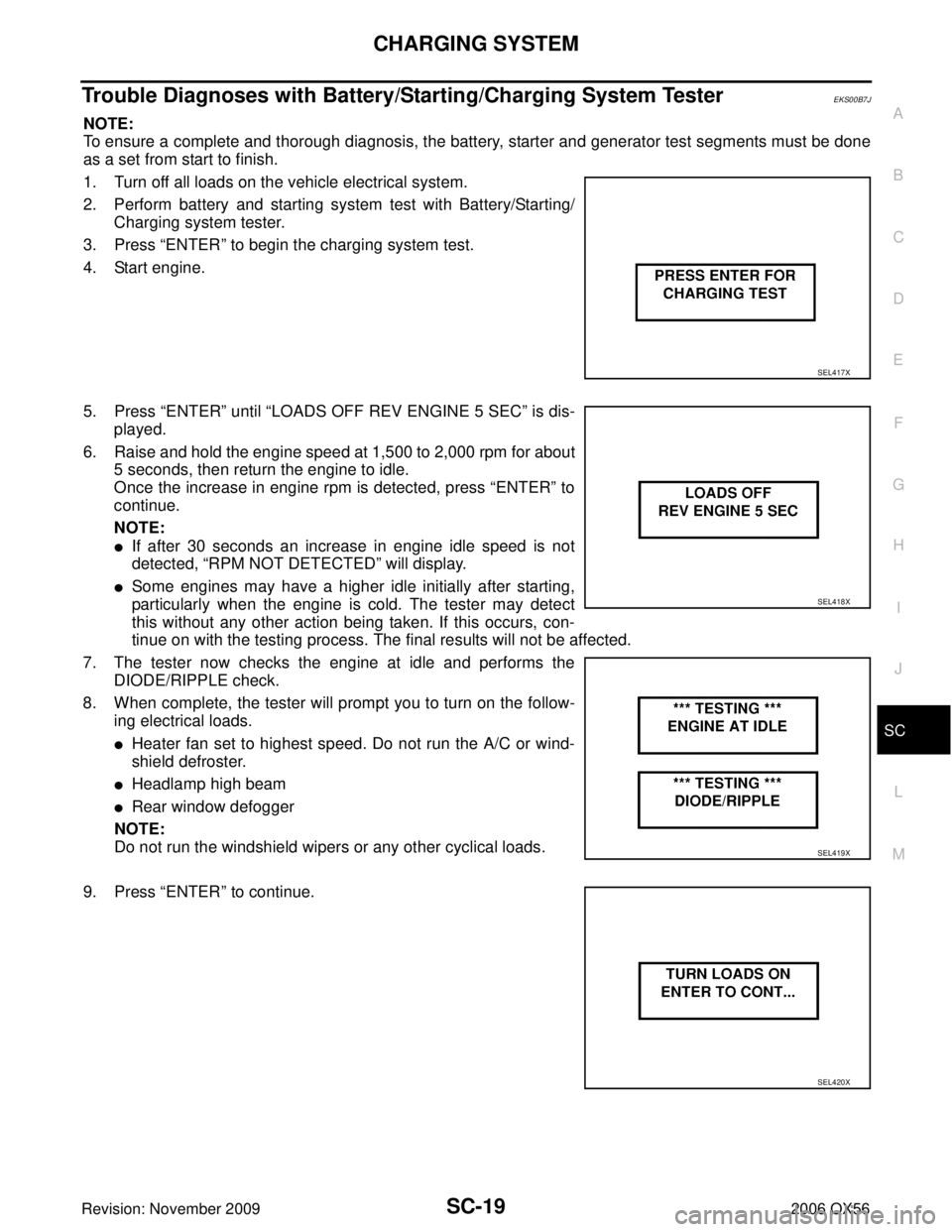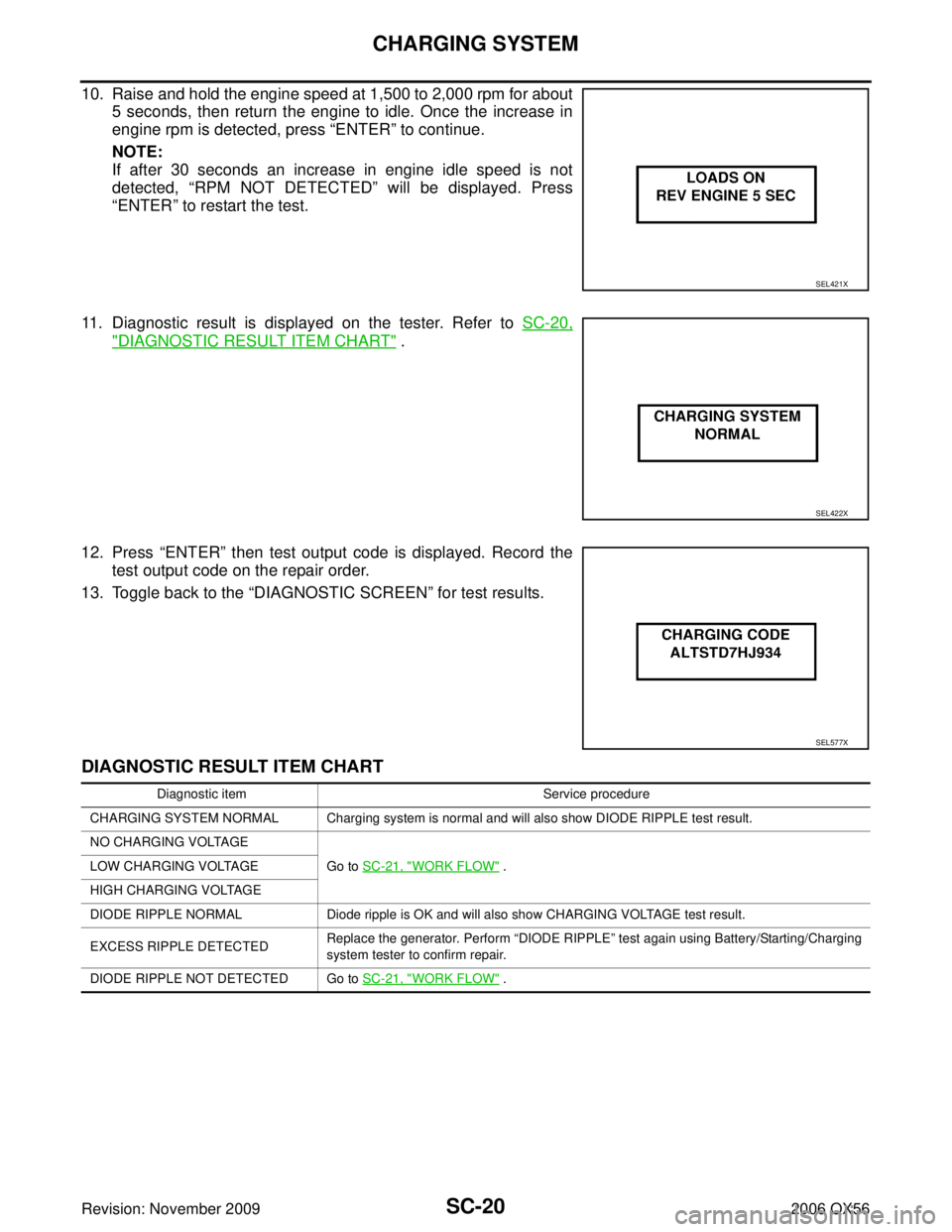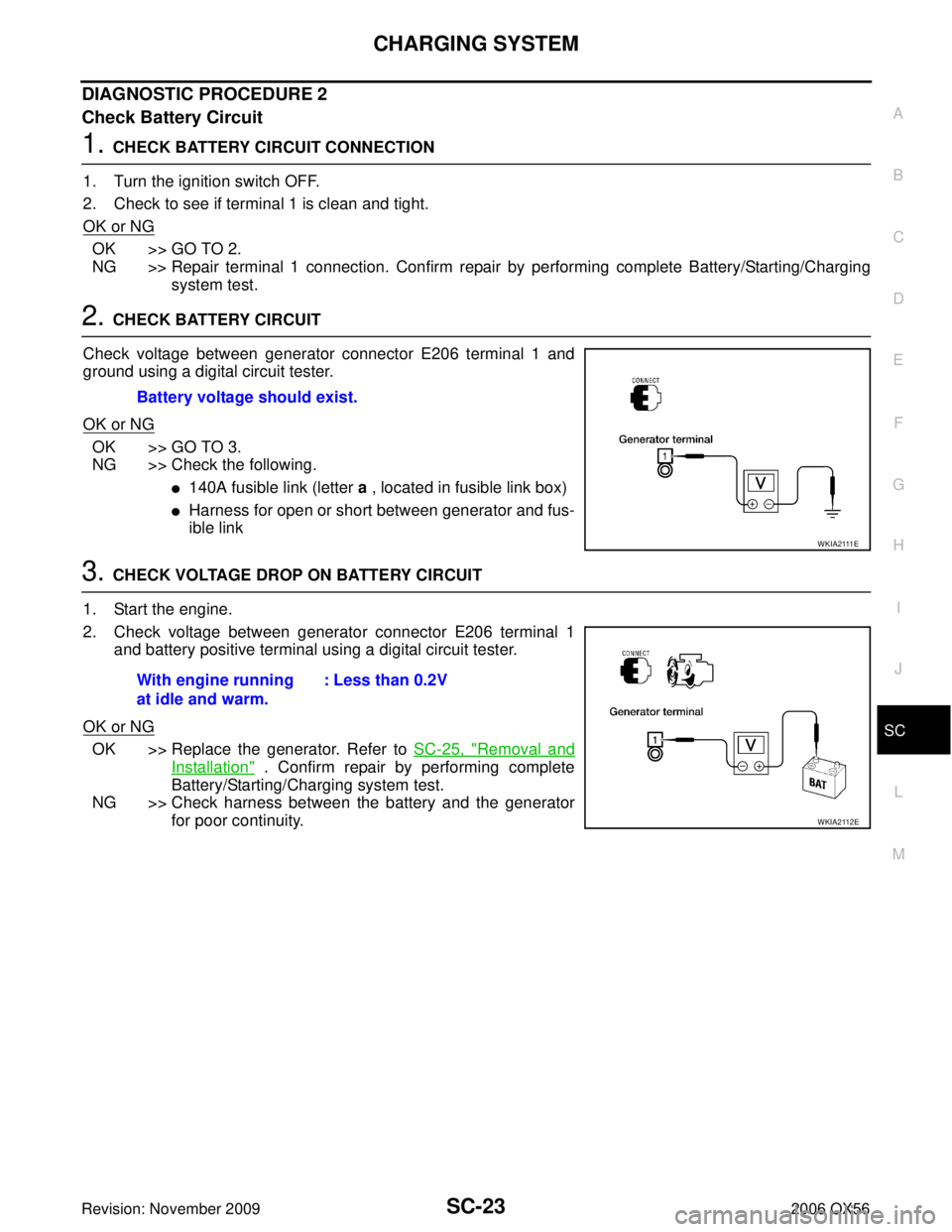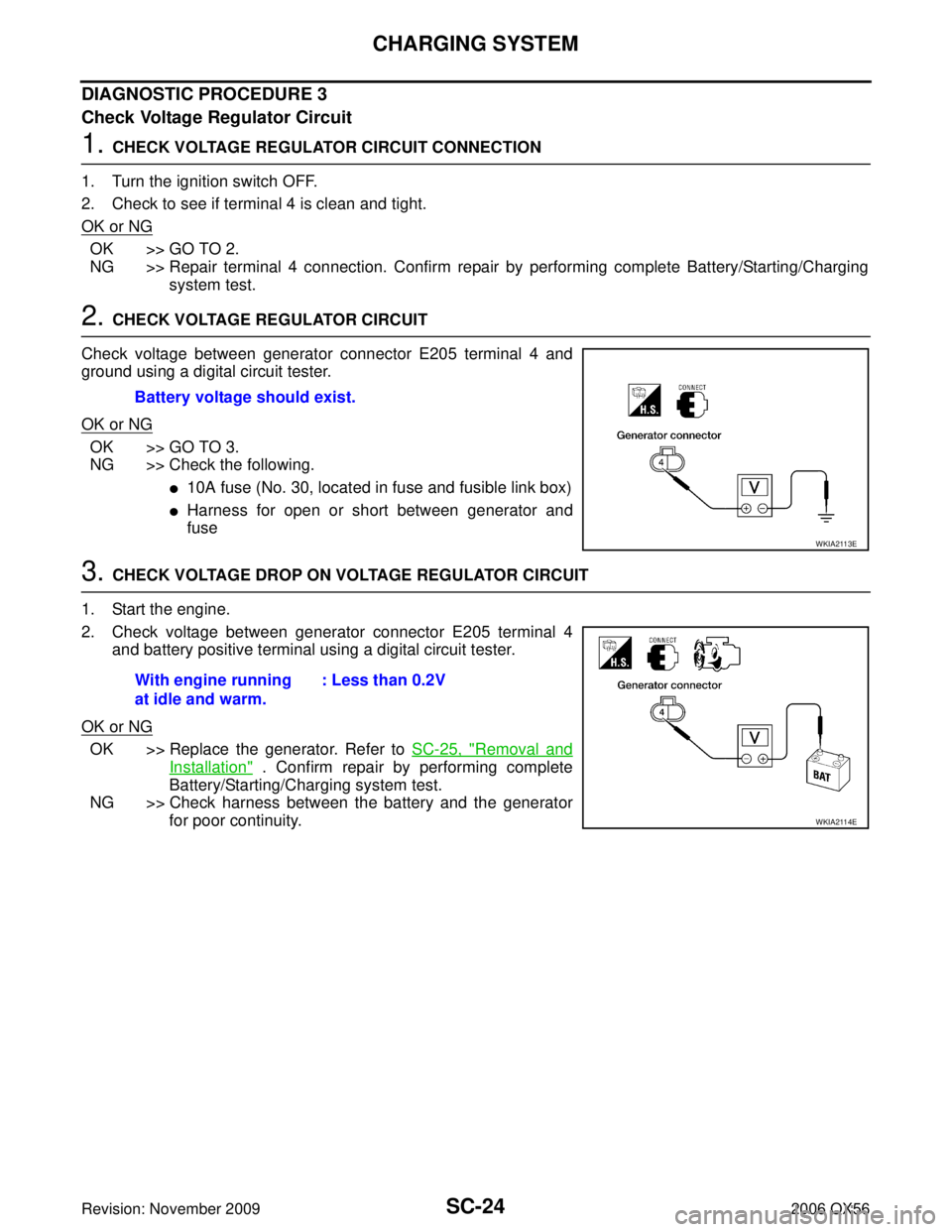Page 2922 of 3383

CHARGING SYSTEMSC-17
C
DE
F
G H
I
J
L
M A
B
SC
Revision: November 2009 2006 QX56
CHARGING SYSTEMPFP:23100
System DescriptionEKS00B7H
The generator provides DC voltage to operate the vehicle's electrical system and to keep the battery charged.
The voltage output is controlled by the IC regulator.
Power is supplied at all times:
�to generator terminal 4
�through 10A fuse (No. 30, located in the fuse and fusible link box).
Terminal 1 supplies power to charge the battery and operate the vehicle's electrical system. Output voltage is
controlled by the IC regulator at terminal 4 detecting the input voltage. The charging circuit is protected by the
140A fusible link (letter a , located in the fusible link box).
Ground is supplied:
�to generator terminal 2
�through body ground E203.
With the ignition switch in the ON or START position, power is supplied:
�through 10A fuse [No. 14, located in the fuse block (J/B)]
�to combination meter terminal 24 for the charge warning lamp.
Ground is supplied to terminal 13 of the combination meter through terminal 3 of the generator. With power
and ground supplied, the charge warning lamp will illuminate. When the generator is providing sufficient volt-
age with the engine running, the ground is opened and the charge warning lamp will go off.
If the charge warning lamp illuminates with the engine running, a fault is indicated.
Page 2924 of 3383

CHARGING SYSTEMSC-19
C
DE
F
G H
I
J
L
M A
B
SC
Revision: November 2009 2006 QX56
Trouble Diagnoses with Battery/Starting/Charging System TesterEKS00B7J
NOTE:
To ensure a complete and thorough diagnosis, the battery, starter and generator test segments must be done
as a set from start to finish.
1. Turn off all loads on the vehicle electrical system.
2. Perform battery and starting system test with Battery/Starting/
Charging system tester.
3. Press “ENTER” to begin the charging system test.
4. Start engine.
5. Press “ENTER” until “LOADS OFF REV ENGINE 5 SEC ” is dis-
played.
6. Raise and hold the engine speed at 1,500 to 2,000 rpm for about 5 seconds, then return the engine to idle.
Once the increase in engine rpm is detected, press “ENTER” to
continue.
NOTE:
�If after 30 seconds an increase in engine idle speed is not
detected, “RPM NOT DETECTED” will display.
�Some engines may have a higher idle initially after starting,
particularly when the engine is cold. The tester may detect
this without any other action being taken. If this occurs, con-
tinue on with the testing process. The final results will not be affected.
7. The tester now checks the engine at idle and performs the DIODE/RIPPLE check.
8. When complete, the tester will prompt you to turn on the follow- ing electrical loads.
�Heater fan set to highest speed. Do not run the A/C or wind-
shield defroster.
�Headlamp high beam
�Rear window defogger
NOTE:
Do not run the windshield wipers or any other cyclical loads.
9. Press “ENTER” to continue.
SEL417X
SEL418X
SEL419X
SEL420X
Page 2925 of 3383

SC-20
CHARGING SYSTEM
Revision: November 20092006 QX56
10. Raise and hold the engine speed at 1,500 to 2,000 rpm for about
5 seconds, then return the engine to idle. Once the increase in
engine rpm is detected, press “ENTER” to continue.
NOTE:
If after 30 seconds an increase in engine idle speed is not
detected, “RPM NOT DETECTED” will be displayed. Press
“ENTER ” to restart the test.
11. Diagnostic result is displayed on the tester. Refer to SC-20,
"DIAGNOSTIC RESULT ITEM CHART" .
12. Press “ENTER” then test output code is displayed. Record the
test output code on the repair order.
13. Toggle back to the “DIAGNOSTIC SCREEN ” for test results.
DIAGNOSTIC RESULT ITEM CHART
SEL421X
SEL422X
SEL577X
Diagnostic item Service procedure
CHARGING SYSTEM NORMAL Charging system is normal and will also show DIODE RIPPLE test result.
NO CHARGING VOLTAGE Go to SC-21, "
WORK FLOW" .
LOW CHARGING VOLTAGE
HIGH CHARGING VOLTAGE
DIODE RIPPLE NORMAL Diode ripple is OK and will also show CHARGING VOLTAGE test result.
EXCESS RIPPLE DETECTED Replace the generator. Perform
“DIODE RIPPLE ” test again using Battery/Starting/Charging
system tester to confirm repair.
DIODE RIPPLE NOT DETECTED Go to SC-21, "
WORK FLOW" .
Page 2927 of 3383
SC-22
CHARGING SYSTEM
Revision: November 20092006 QX56
DIAGNOSTIC PROCEDURE 1
Check Charge Warning Lamp Circuit
1. CHECK CHARGE WARNING LAMP CIRCUIT CONNECTION
1. Turn the ignition switch OFF.
2. Check to see if terminal 3 is clean and tight.
OK or NG
OK >> GO TO 2.
NG >> Repair terminal 3 connection. Confirm repair by performing complete Battery/Starting/Charging system test.
2. CHECK CHARGE WARNING LAMP CIRCUIT
1. Disconnect E205 connector from generator.
2. Apply ground to connector E205 terminal 3 with the ignition switch in the ON position.
OK or NG
OK >> GO TO SC-21, "WORK FLOW" .
NG >> Check the following.
�10A fuse [No. 14, located in fuse block (J/B)]
�Charge warning lamp
�Harness for open or short between combination
meter and fuse
�Harness for open or short between combination meter and generator
Charge warning lamp should
light up.
WKIA2110E
Page 2928 of 3383

CHARGING SYSTEMSC-23
C
DE
F
G H
I
J
L
M A
B
SC
Revision: November 2009 2006 QX56
DIAGNOSTIC PROCEDURE 2
Check Battery Circuit
1. CHECK BATTERY CIRCUIT CONNECTION
1. Turn the ignition switch OFF.
2. Check to see if terminal 1 is clean and tight.
OK or NG
OK >> GO TO 2.
NG >> Repair terminal 1 connection. Confirm repair by performing complete Battery/Starting/Charging system test.
2. CHECK BATTERY CIRCUIT
Check voltage between generator connector E206 terminal 1 and
ground using a digital circuit tester.
OK or NG
OK >> GO TO 3.
NG >> Check the following.
�140A fusible link (letter a , located in fusible link box)
�Harness for open or short between generator and fus-
ible link
3. CHECK VOLTAGE DROP ON BATTERY CIRCUIT
1. Start the engine.
2. Check voltage between generator connector E206 terminal 1 and battery positive terminal using a digital circuit tester.
OK or NG
OK >> Replace the generator. Refer to SC-25, "Removal and
Installation" . Confirm repair by performing complete
Battery/Starting/Charging system test.
NG >> Check harness between the battery and the generator for poor continuity.
Battery voltage should exist.
W K I A 2 111 E
With engine running
at idle and warm.
: Less than 0.2V
WKIA2112E
Page 2929 of 3383

SC-24
CHARGING SYSTEM
Revision: November 20092006 QX56
DIAGNOSTIC PROCEDURE 3
Check Voltage Regulator Circuit
1. CHECK VOLTAGE REGULATOR CIRCUIT CONNECTION
1. Turn the ignition switch OFF.
2. Check to see if terminal 4 is clean and tight.
OK or NG
OK >> GO TO 2.
NG >> Repair terminal 4 connection. Confirm repair by performing complete Battery/Starting/Charging system test.
2. CHECK VOLTAGE REGULATOR CIRCUIT
Check voltage between generator connector E205 terminal 4 and
ground using a digital circuit tester.
OK or NG
OK >> GO TO 3.
NG >> Check the following.
�10A fuse (No. 30, located in fuse and fusible link box)
�Harness for open or short between generator and
fuse
3. CHECK VOLTAGE DROP ON VOLTAGE REGULATOR CIRCUIT
1. Start the engine.
2. Check voltage between generator connector E205 terminal 4 and battery positive terminal using a digital circuit tester.
OK or NG
OK >> Replace the generator. Refer to SC-25, "Removal and
Installation" . Confirm repair by performing complete
Battery/Starting/Charging system test.
NG >> Check harness between the battery and the generator for poor continuity.
Battery voltage should exist.
WKIA2113E
With engine running
at idle and warm.
: Less than 0.2V
WKIA2114E
Page 2930 of 3383
CHARGING SYSTEMSC-25
C
DE
F
G H
I
J
L
M A
B
SC
Revision: November 2009 2006 QX56
MALFUNCTION INDICATOR
The IC regulator warning function activates to illuminate “CHARGE” warning lamp, if any of the following
symptoms occur while generator is operating:
�Excessive voltage is produced.
�No voltage is produced.
Removal and InstallationEKS00B7K
REMOVAL
1. Disconnect the negative battery terminal.
2. Remove the fan shroud. Refer to CO-14, "
Removal and Installation" .
3. Remove the drive belt. Refer to EM-13, "
Removal and Installation" .
4. Remove the lower bracket, using power tools.
5. Remove the generator upper bolt, using power tools.
6. Remove/disconnect the generator harness connectors.
7. Remove the generator.
INSTALLATION
Installation is in the reverse order of removal.
�Install the generator and check the tension of the drive belt. Refer to EM-13, "DRIVE BELT TENSION" .
CAUTION:
Tighten terminal nut carefully.
WKIA1390E
Terminal nut : 10.8 N·m (1.1 kg-m, 8 ft-lb)
Page 2931 of 3383

SC-26
SERVICE DATA AND SPECIFICATIONS (SDS)
Revision: November 20092006 QX56
SERVICE DATA AND SPECIFICATIONS (SDS)PFP:00030
BatteryEKS00B7M
StarterEKS00B7N
GeneratorEKS00B7O
Ty p eGr. 27
Capacity (20 HR) minimum 12V - 80AH
Cold cranking current A
(For reference value) 710
Application
All models
Manufacturer Mitsubishi
M002T85571ZCKD
Ty p e Reduction gear type
System voltage 12V
No-load Terminal voltage
11V
Current Less than 145A
Revolution More than 3,300 rpm
Minimum diameter of commutator 31.4 mm (1.236 in)
Minimum length of brush 11.0 mm (0.433 in)
Brush spring tension 26.7 - 36.1 N (2.72 - 3.68 kg, 5.93 - 8.02 lb)
Clearance between pinion front edge and
pinion stopper 0.5 - 2.0 mm (0.020 - 0.079 in)
Ty p e LR1130-701
Hitachi
Nominal rating 12V - 130A
Ground polarity Negative
Minimum revolution under no-load (When 13.5 volts is applied) 1,200 rpm
Hot output current (When 13.5 volts is applied) More than 78A/1,800 rpm
More than 108A/2,500 rpm
More than 130A/5,000 rpm
Regulated output voltage 14.1 - 14.7V @ 25°C
Minimum length of brush 6 mm (0.24 in)
Brush spring pressure 1.0 - 3.432 N (0.102 - 0.3501 kg, 0.22 - 0.7715 lbs)
Slip ring minimum outer diameter 26 mm (1.02 in)
Rotor (Field coil) resistance 2.1 ohms